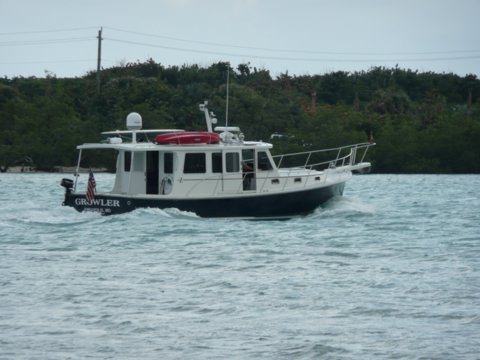It is about that time when many cruisers will be back on our waterways, heading in all directions. Bringing the boat north for the summer, doing the Loop, or onto SE Alaska, the new season is such an exciting time. On some of our rivers and bays, it can seem like the Wild West. Boats of all sizes are out, going at different speeds and directions, all moving independent of each other.
That is fine, but it gets more focused on narrowing inlets, rivers, and canals.
Following a power cat in the Dismal Swamp in North Carolina, as a string of trawlers and sailboats left the locks. Not much room to pass here!
It is standard practice to hail a slower boat in front of you, requesting a slow pass on one side or the other. On large, stabilized motor vessels and trawlers, the skipper will often acknowledge your call and tell you to go by at your normal speed, as the fin stabilizers will counter any roll he or she might otherwise experience due to your passing wake.
Many large yachts travel the ICW. All are stabilized and aren't bothered by a little wake as you pass by. Such a small world, you always see boats you've seen before, maybe last year in Marathon or in Roche Harbor.
A problem occurs when you approach another boat, but the captain has pulled the dinghy onto the swim platform, often using Weaver Dinghy Snaps, which can cover the name of the vessel and hailing port. Unless you both have AIS, you have difficulty hailing the boat by name. Which is why some owners paint the trawler's name on the bottom of the dinghy.
I have traveled the ICW from beginning to end in both directions many times, and there is another common scenario. Approaching another boat in a narrow waterway, such as the Rock Pile in South Carolina, there may not be room to safely go around a slower vessel. I recall a sailboat ahead of me from Montreal. The guy at the wheel was bundled up on this October day, having been under way for weeks from Canada. His long days of dawn to dusk travel put him in an tired stupor. I couldn't reach him on the radio as he wasn't near it. And he was motoring down the center of the channel at 5 knots.
That is when I use my horn to both get his attention and signal my intentions. On Spitfire, our PDQ 41 power cat, we installed the Kahlenberg air horn system, an excellent horn far superior to those from West Marine that rust out every couple of years. When I hit the horn button, it let out a sound so loud the fellow almost jumped into the air. He must have thought we were a Navy warship or large ship. I simply pointed that I would pass him on my starboard side. He turned right a bit and I slid past him without drama.
Having a good horn is important, and cruisers should make sure it works while reacquainting themselves with its proper use before beginning the cruising season, especially if there is the likelihood of encountering commercial traffic.
One Short Blast, one Toot, means I intend to turn right and pass you on my port side. This applies to both overtaking a boat ahead of you, or when a boat is coming at you from the opposite direction.
Two Short Blasts, two Toots, means I intend to turn left and pass you on my starboard side. This is my normal procedure when overtaking a slower boat in front of me.
Update: As a couple of readers point out, (and I am therefore adding it here) the vessel you signal should acknowledge your blasts with the same one or two toots. If they respond with five blasts, it means there is danger or they do not agree. Perhaps they see something up ahead that you can't see.
One also must be aware of one’s wake when passing, and it is common courtesy to slow down when you pass another vessel, especially if you are driving a boat that throws a big bow wave, such as a classic Grand Banks going double-digit speed. Spitfire did not produce much wake, so it was not an issue. On Growler, our Zimmerman 36, I would slow down as I passed another boat to lower my wake.
This was taken by a woman aboard a Krogen 42 I just passed. The couple recognized Growler and waved to us.
There is a lot written on the rules of the road, and the meaning of sound signals, but maybe this is enough of a refresh to help you as the migration north begins. At the moment, if you are coming north on the East Coast, I suggest staying inside if you can, with those 70+ containers floating around off the coast of North Carolina. They came off a ship during a recent storm. Hitting one of them would make for a really bad day.
Have a great week. Around Annapolis, there are a few boats out and about, but not many. Blue Angel remains under shrinkwrap, and we expect some snow in a couple of days. As for me, well, I’m walking a lot, putting miles on my new boots. I'm preparing for the Camino de Santiago next month. The Walk of St James on the Frances Route, a pilgrimage to clear the mind and soul.
Been wanting to do this for awhile. Buen Camino.














